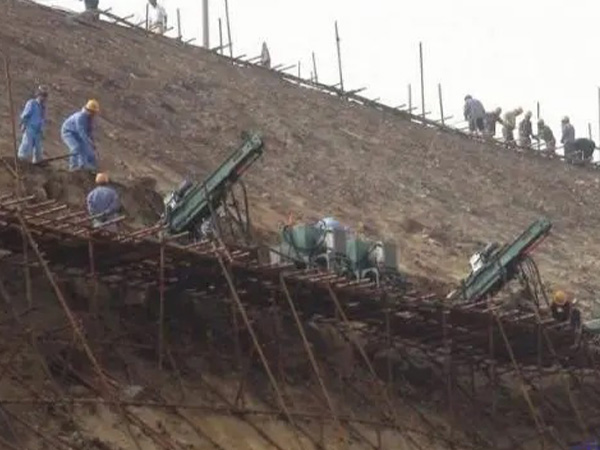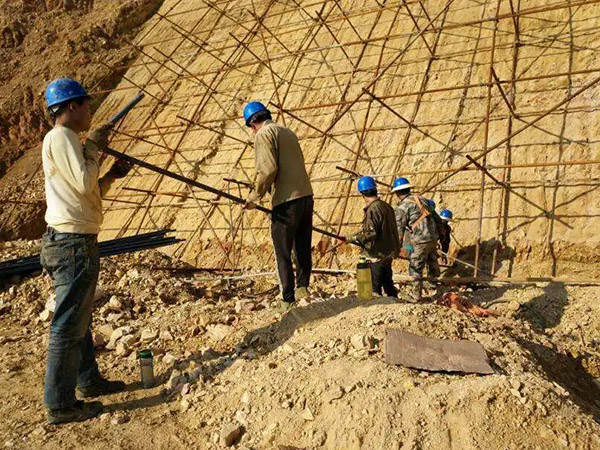Product Details
PRODUCT CENTER
Mine anchor cables
Drilling is a key process in anchor cable construction to control the construction period. In order to ensure drilling efficiency and ensure drilling quality, DTH impact drilling rigs are used. When the drilling rig drills, the drill pipe required for drilling is neatly arranged according to the design length of the anchor cable, the drill pipe is used up, and the hole depth is just in place. The drilling depth should exceed the design length of the anchor cable by about 0.5m.
At the end of drilling, pull out the drill pipe and drilling tool one by one, and clean the impactor for later use. Use a polyethylene pipe to check the hole depth, and blow the hole with high-pressure air, and when the dust in the hole is blown clean and the hole depth is not less than the design length of the anchor cable, pull out the polyethylene pipe and plug the hole.
Treatment of two special cases:
Treatment of water seepage. In the drilling process or after the end of the drilling blowing hole, from the hole are blown out of some small stones and gray or yellow agglomerates without dust, indicating that there is water seepage in the hole, rock powder is attached to the hole wall, at this time, if the hole depth is enough, inject clean water, blow clean with high-pressure wind, until clear water is blown out; If the hole depth is not enough, although the impactor is working, there is still an intake, and the drilling must be stopped immediately, the drilling tool must be pulled out, and the drilling must be continued after washing the hole, and so on until the end of the cycle. Sometimes there is a large amount of water seepage in the hole, there is stagnant water, and the blowing out is mud and gravel, in this case, the rock powder will not stick to the hole wall, as long as the impactor works, you can continue to drill. If the amount of water seepage is so large that the impactor is flooded, the impactor will automatically stop working and the drilling tool should be pulled out for pressure grouting
Treatment of collapsed holes and jamming drills. Collapse often occurs when holes pass through strongly weathered rock formations or rock mass fracture zones. The main sign of the collapsed hole is to blow out yellow rock powder from the hole, mixed with some original (non-drill bit broken, non-fresh, matte) stones, at this time, regardless of the drilling depth, it is necessary to immediately stop drilling, pull out the drilling tool, and carry out solid wall grouting with a grouting pressure of 0.4 MPa, the slurry is a mixture of cement mortar and water glass, and the hole is re-drilled after 24 hours. In the rainy season, mud often seeps into the hole along the rock mass crushing zone, and before solid wall grouting is injected, the mud must be washed out with water and wind (the stones that collapse into the borehole do not have to be removed), otherwise, not only the solid wall grouting effect is poor, but also easy to cause illusions.
The anchor cable is woven on site at the same time as the hole is drilled, the inner anchor section adopts a corrugated shape, and the tension section adopts a straight shape. The steel grain line blanking length is the sum of the anchor cable design length, anchor head height, jack length, tool and work anchor thickness, and tension operation allowance. Under normal circumstances, the truncation margin of steel strands is taken as 50mm. Place the truncated steel strand smoothly on the working bench, measure out the inner anchor section and the design length of the anchor cable, and mark them separately; Wear the alignment isolation bracket within the range of the inner anchor section, with a spacing of 60--100cm, and tie a fastening ring between the two pairs of middle brackets; The tension section is also tied with a fastening ring per meter, and a plastic pipe is used to cover it, and the inside is coated with butter; Finally, put a guide cap on the anchor cable end head.

